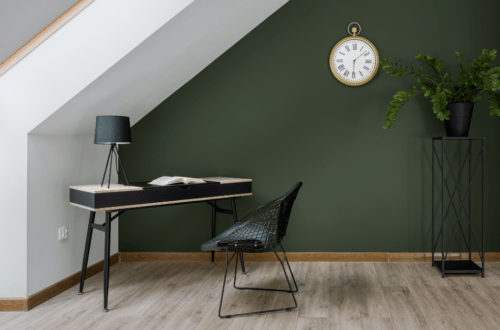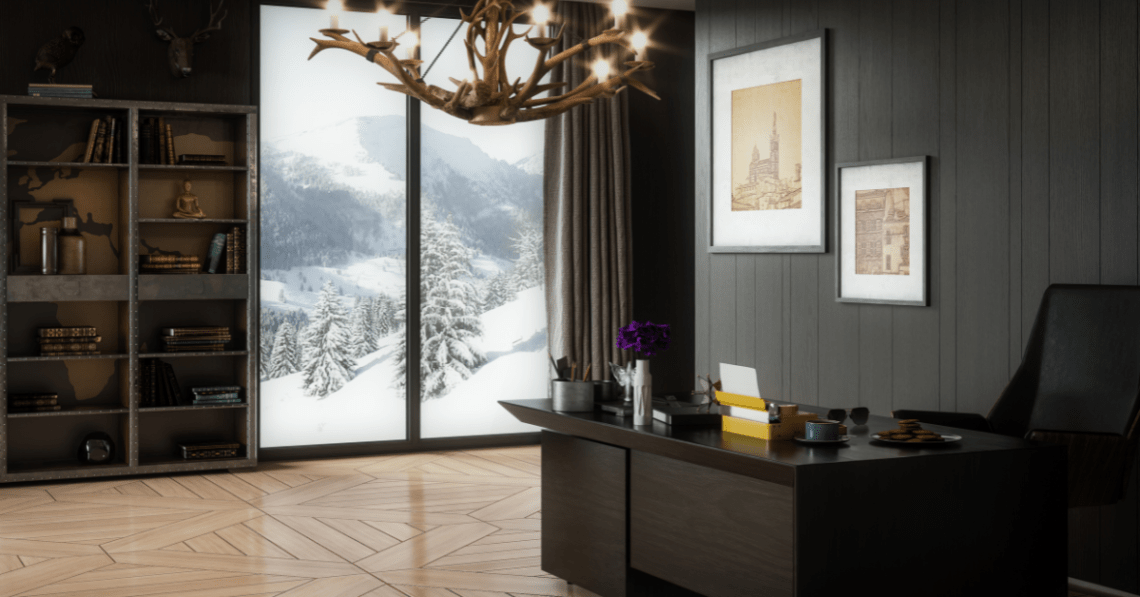
Elevate Your Workspace: The Ultimate Guide to Designing a Moody Office
Transforming a home office space into a moody and inspirational environment can significantly impact your productivity and creative flow. The environment where you work plays a critical role in how well you focus (as much as how you dress), how inspired you feel, and ultimately, how productive you are. But what exactly is a moody office? It’s not just about painting your walls dark or dimming the lights; it’s about creating a space that evokes depth, warmth, and a sense of comfort that’s conducive to deep thinking and innovation.
Table of Contents
ToggleWhat is a Moody Office?
A moody office is more than just a design trend—it’s a thoughtful approach to crafting a work environment that resonates with deep colors, strategic lighting, and rich textures. The goal is to create a space that feels both sophisticated and inviting, allowing you to immerse yourself in your work without distraction.
The Concept Behind Moody Interiors
Understanding the Psychological Impact of Deep Colors
Colors can significantly influence our emotions and mental state. Deep colors like navy blue, charcoal gray, and forest green are often associated with feelings of calmness, introspection, and focus. These colors help in creating a sense of depth in a room, which can make every space feel more expansive and less cluttered.
How a Moody Office Sets the Tone for Productivity
When designed with intention, a moody office can create an environment that’s conducive to concentration and creativity. The subdued tones and layered textures provide a backdrop that minimizes distractions, allowing you to dive deep into your work and stay in the zone for longer periods.

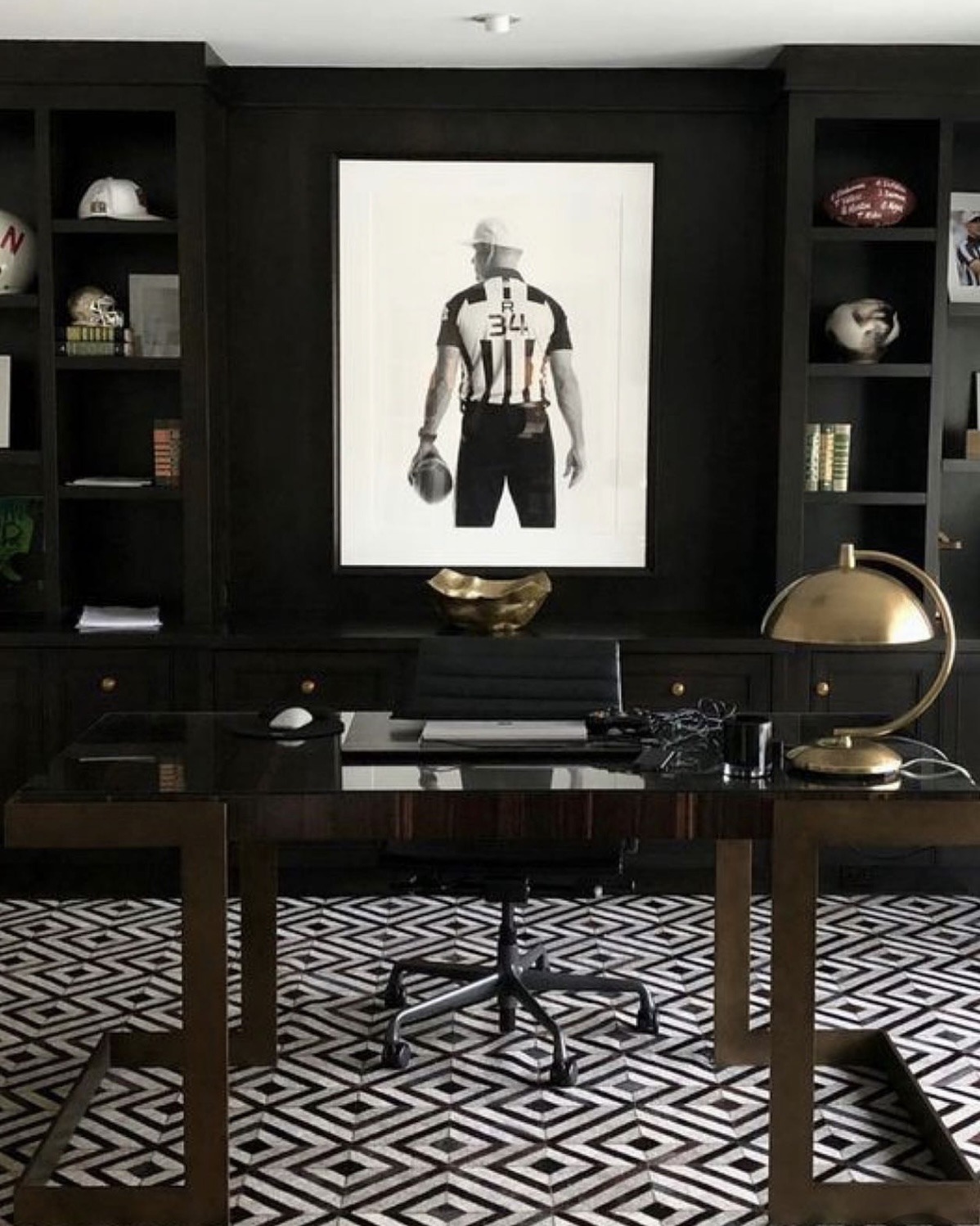

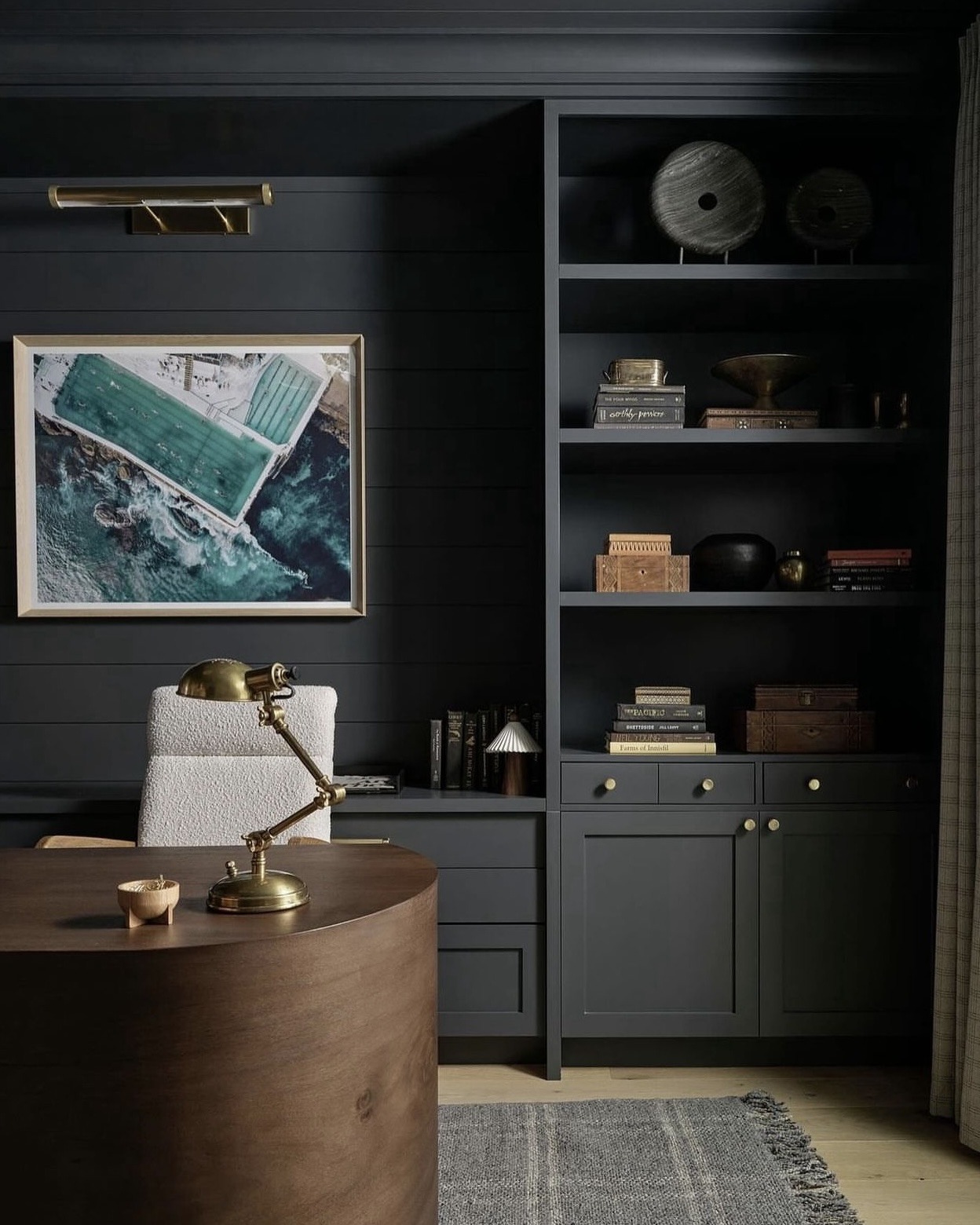

Key Elements of a Moody Office
Colors and Their Significance in a Moody Setting
The choice of colors is crucial in setting the tone of a moody office. Opt for darker, richer hues that evoke a sense of elegance and calm. These colors can be balanced with lighter accents to prevent the space from feeling too heavy or oppressive.
The Role of Lighting in Creating a Moody Atmosphere
Lighting is the unsung hero of moody interiors. The right lighting can highlight the depth of your color choices and enhance the overall vibe of the room. Whether it’s natural light filtering through a window or a carefully placed desk lamp, lighting should be both functional and atmospheric.
Textures and Materials That Enhance the Mood
Textures play a vital role in adding warmth and interest to a moody office. Rich materials like velvet, leather, and wood can create a luxurious feel, while rugged, industrial textures can add an edge that balances the softness of darker colors.
1. The Role of Colors in a Moody Office
Choosing the Right Color Palette
Dark Colors: Creating Depth and Sophistication
Dark colors are the cornerstone of a moody office. Think deep blues, dark greens, and even black. These colors create a backdrop that feels sophisticated and timeless, adding a sense of depth to the space that makes it feel larger and more cohesive.
Accent Colors: Adding Vibrancy Without Losing the Mood
While dark colors dominate, don’t shy away from accent colors. Gold, brass, and deep reds can be used sparingly to add vibrancy and break up the monotony of darker shades. These accents should complement rather than overpower the overall mood of the space.


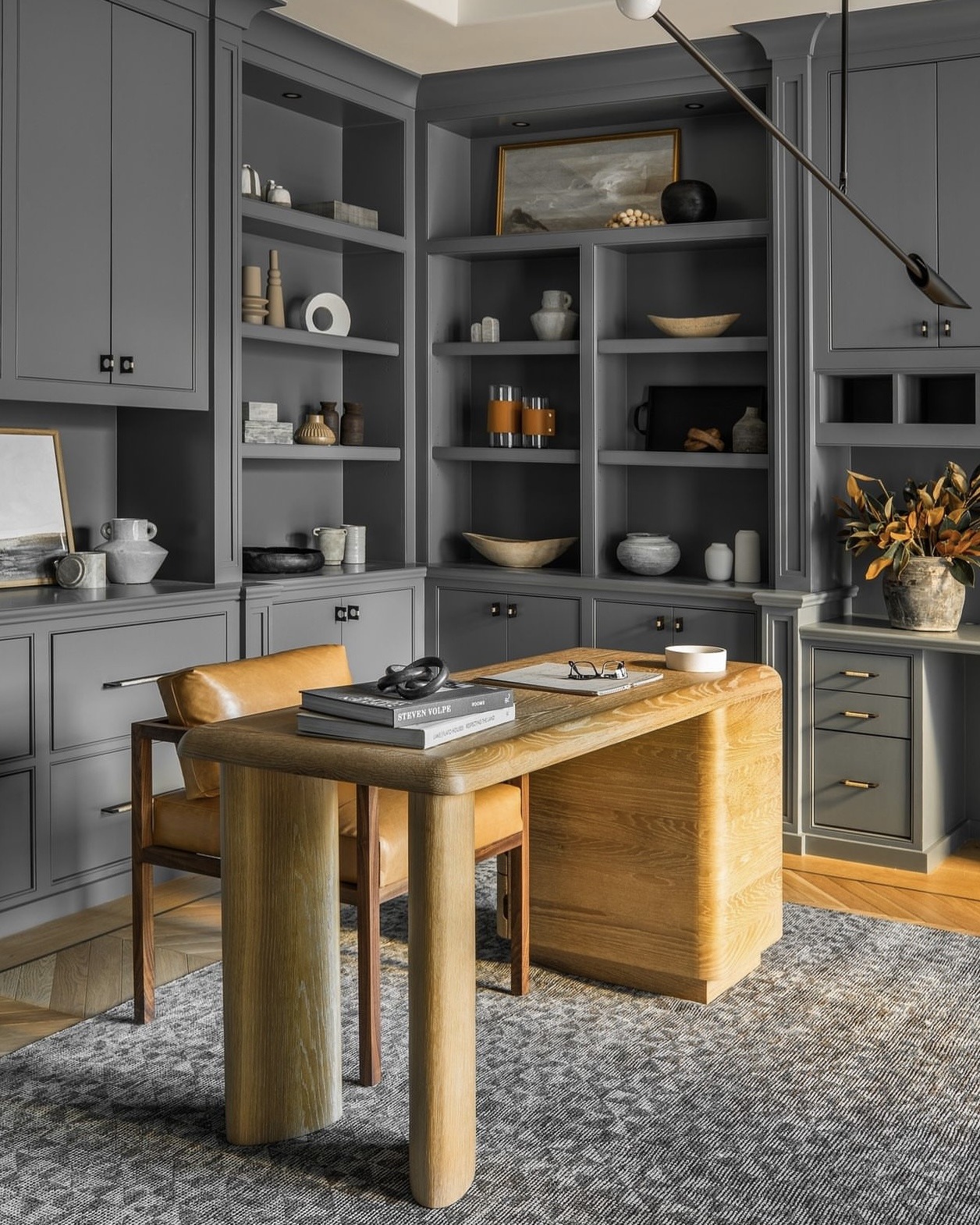




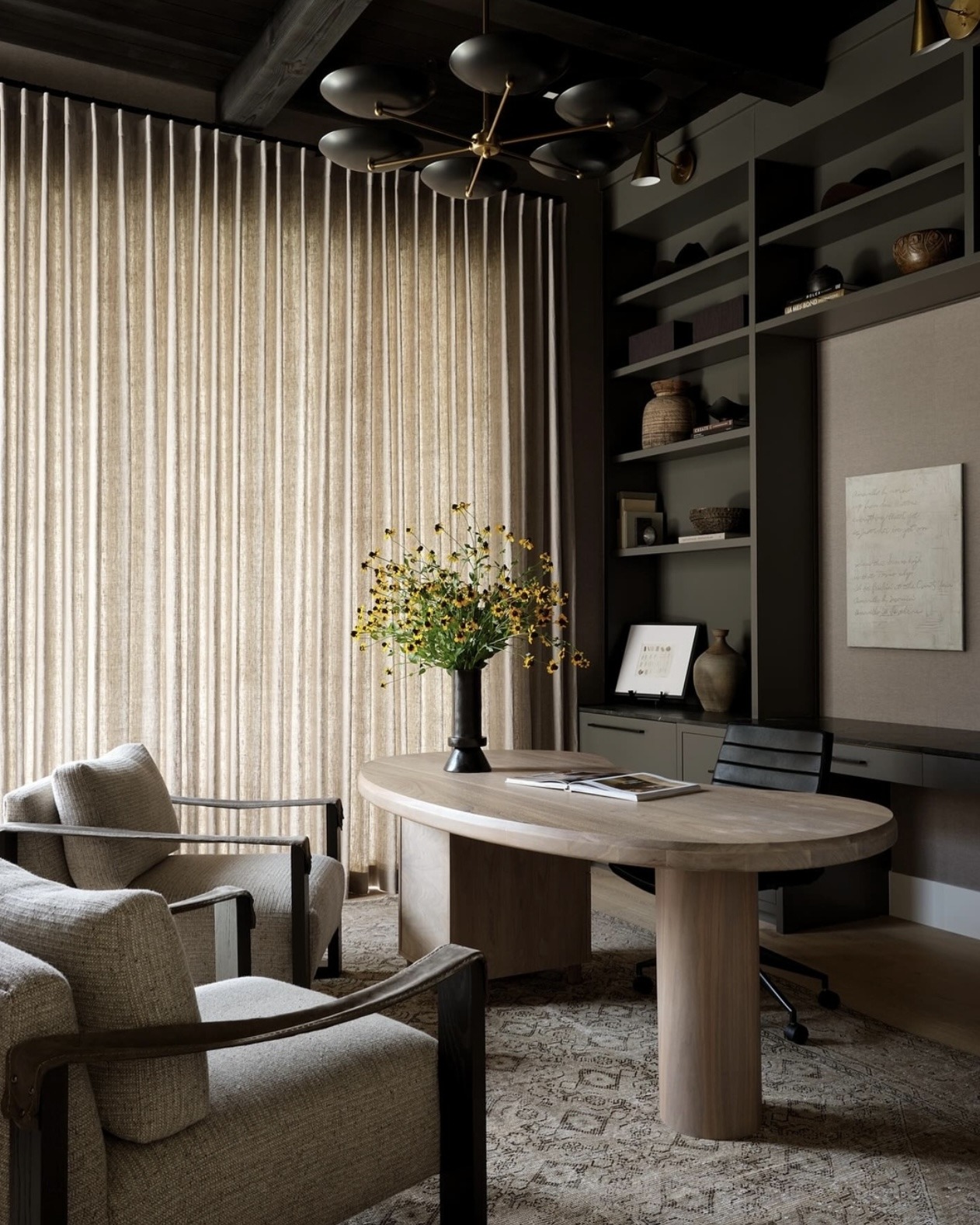

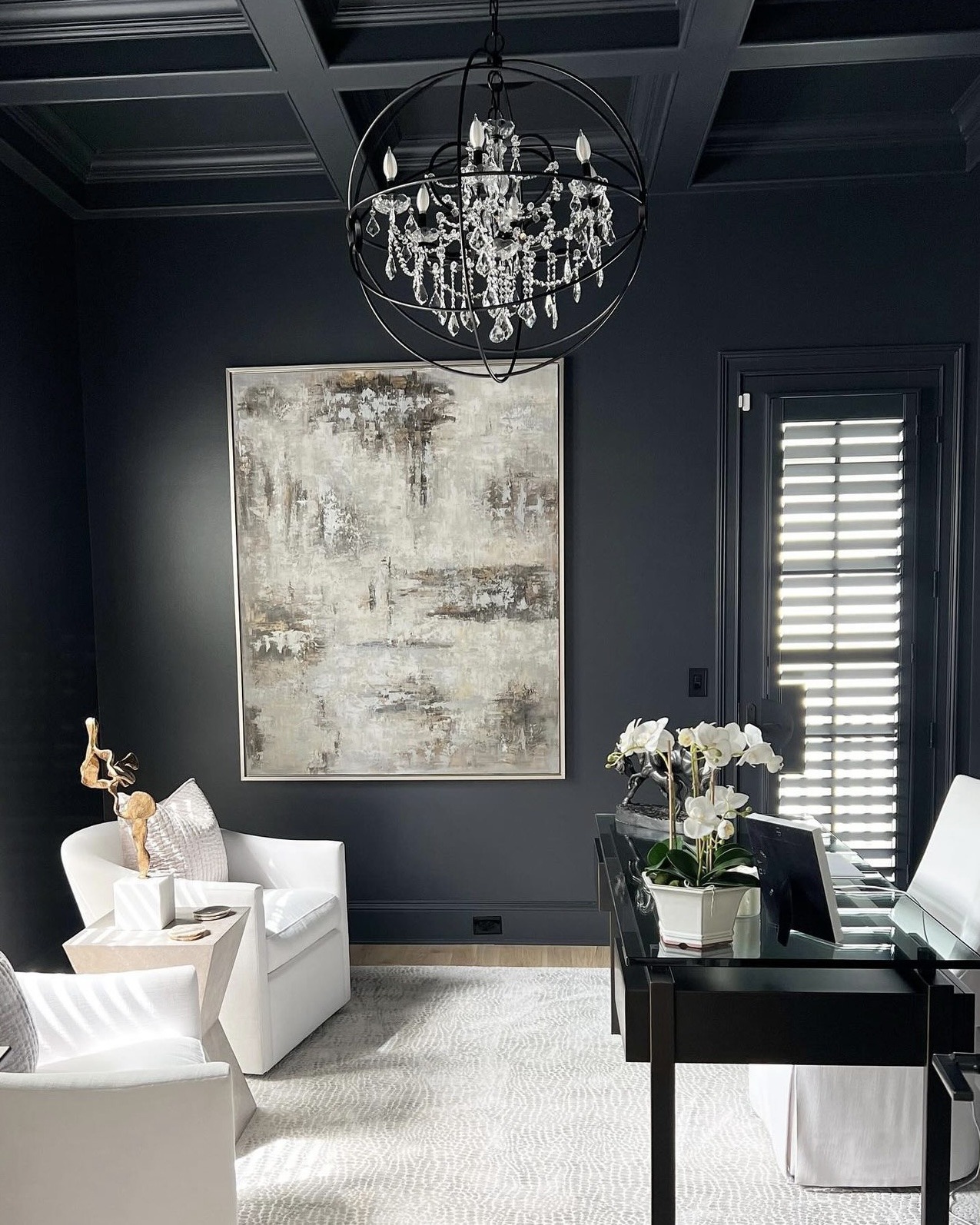
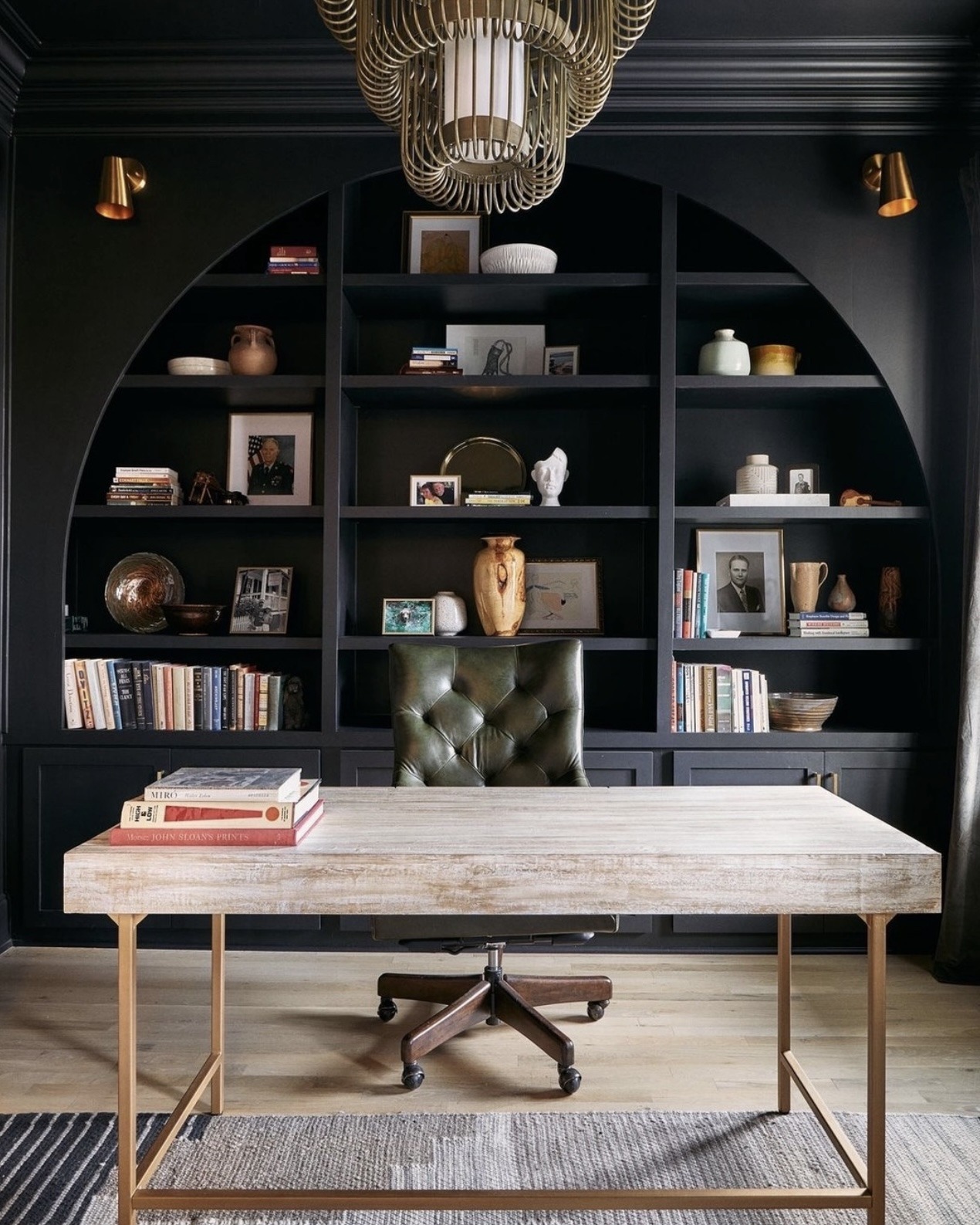

How Different Colors Affect Mood and Productivity
Blue Tones: Calmness and Focus
Blue is often associated with calm and focus, making it an excellent choice for a moody office. Lighter blues can bring in a sense of openness, while darker shades like navy can add depth and help maintain a tranquil environment.
Greens and Earth Tones: Connection to Nature and Tranquility
Greens, especially those reminiscent of nature, can create a sense of tranquility in a workspace. Earth tones like olive and moss can make the space feel grounded and connected to the outdoors, which can be particularly beneficial in small offices with limited access to natural light.
2. Strategic Lighting for a Moody Office
Natural vs. Artificial Lighting
Maximizing Natural Light for Balance
Natural light is invaluable in a moody office. It adds warmth and ensures that the space doesn’t feel too dark or cave-like. If possible, position your desk near a window to take advantage of natural light, using sheer curtains to diffuse the light without blocking it completely.
Using Artificial Lighting to Set the Mood
Artificial lighting should be chosen carefully to enhance the moody atmosphere. Consider using dimmable lights that allow you to adjust the brightness based on the time of day or the task at hand. Warm-toned bulbs can add a soft glow that complements the darker color palette.
Types of Lighting to Consider
Ambient Lighting: Setting the General Mood
Ambient lighting is your main source of light, providing overall illumination to the room. In a moody office, ambient lighting should be soft and diffused, avoiding harsh overhead lights that can disrupt the atmosphere.
Task Lighting: Enhancing Focus and Functionality
Task lighting is essential for areas where you need to focus on specific tasks, such as reading or writing. Desk lamps with adjustable arms or under-cabinet lights can provide the necessary illumination without disturbing the overall mood of the room.
Accent Lighting: Highlighting Key Features and Decor
Accent lighting is used to highlight specific areas or features in your office. This could be a piece of artwork, a bookshelf, or an architectural element. Accent lights can create focal points and add depth to the room, enhancing the moody aesthetic.



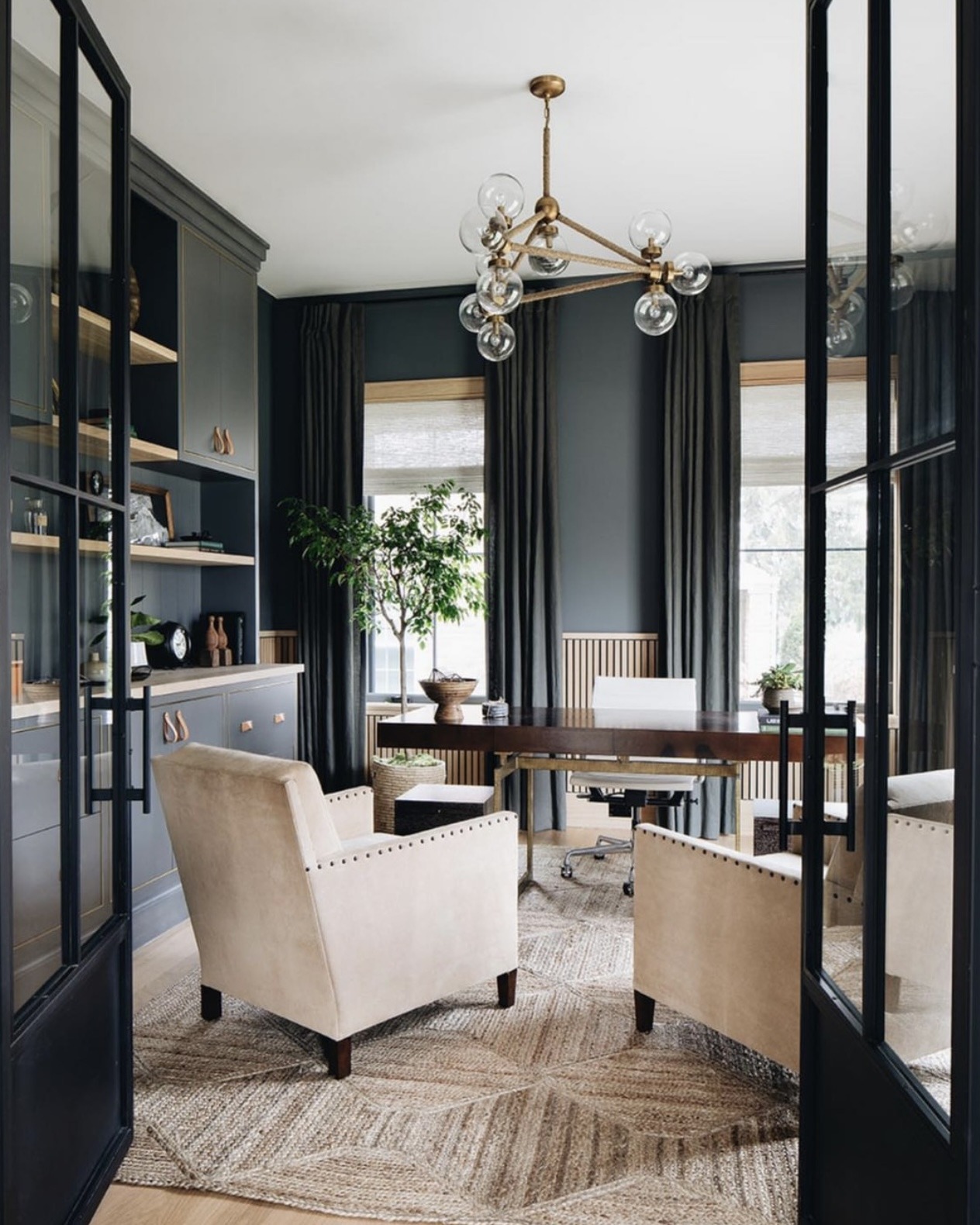




3. Textures and Materials for a Moody Office
Incorporating Rich Textures
Velvet, Leather, and Wood: Adding Luxury and Warmth
Rich textures like velvet, leather, and wood are perfect for a moody office. Velvet upholstery can add a touch of luxury, while leather and dark wood furniture bring warmth and a sense of tradition to the space.
Rugged and Industrial Materials: Balancing Modern and Cozy
For a more modern take on the moody office, consider incorporating industrial materials like metal, concrete, and exposed brick. These materials can add a rugged edge that contrasts beautifully with softer textures, creating a balanced and dynamic environment.
The Impact of Textures on Ambience
How Soft and Hard Textures Influence Mood
The combination of soft and hard textures can greatly influence the mood of your office. Soft textures like plush rugs and velvet cushions add comfort and coziness, while hard textures like metal and wood bring structure and order, helping to maintain a productive atmosphere.
Combining Different Textures for a Dynamic Environment
Don’t be afraid to mix different textures to create a layered, dynamic environment. For example, a velvet chair paired with a metal desk can create an interesting contrast that adds depth and character to the space.
4. Furniture and Decor for a Moody Office
Choosing the Right Furniture
Dark Wood and Metal: Creating a Cohesive Look
When selecting furniture for a moody office, dark wood and metal are excellent choices. These materials not only complement the deep color palette but also add a sense of cohesion and sophistication to the space.
Comfortable Yet Stylish Seating Options
Comfort should never be sacrificed for style. Look for seating that is both comfortable and aesthetically pleasing. A well-upholstered chair in a rich fabric can provide the perfect balance between comfort and style.
Decor Elements to Enhance the Mood
Artwork and Photography: Inspiring Creativity
Art plays a crucial role in a moody office, serving as both a focal point and a source of inspiration. Choose artwork and photography that resonates with you, whether it’s abstract pieces that stimulate creativity or serene landscapes that promote calm.
Plants and Greenery: Adding Life and Balance
Adding plants to your office can breathe life into the space, literally and figuratively. Plants bring a touch of nature indoors, which can be particularly refreshing in a dark, moody office. They also help to purify the air and can improve overall well-being.
Personal Touches: Making the Space Your Own
Personal touches are what truly make a space feel like your own. Whether it’s a collection of your favorite books, a vintage lamp, or a unique sculpture, these items add personality to your office and make it a place where you’ll love spending time.
@beigewhitegray ✨ From Hodgepodge to Dream Office: Blending Light and Moody Vibes! ✨🖤 #OfficeTransformation #DreamyWorkspace #LightAndMoody #OfficeMakeover #HomeDecorInspo #WorkFromHomeStyle ♬ Golden Hour: Piano Version - Andy Morris
5. Maximizing Small Office Spaces
Layout Ideas for Small Moody Offices
Smart Furniture Arrangement for Limited Spaces
In a small office, every square inch counts. Opt for furniture that’s proportionate to the size of the room and arrange it in a way that maximizes both space and functionality. Floating shelves and wall-mounted desks are great options for saving floor space.
Using Vertical Space Effectively
Don’t forget about vertical space. Tall bookshelves, wall-mounted storage, and even hanging plants can help you make the most of a small office. Using vertical space not only saves room but also draws the eye upward, making the space feel larger.
Multi-Functional Furniture and Storage Solutions
Furniture That Doubles as Storage
In a small moody office, multi-functional furniture is key. Consider a desk with built-in drawers or a storage ottoman that doubles as seating. These pieces help keep the space organized without sacrificing style.
Hidden Storage Ideas for a Clutter-Free Environment
Clutter can quickly ruin the vibe of a moody office. Hidden storage solutions, such as under-desk drawers, wall-mounted cabinets, or even a stylish storage trunk, can help keep your workspace tidy and maintain the overall aesthetic.







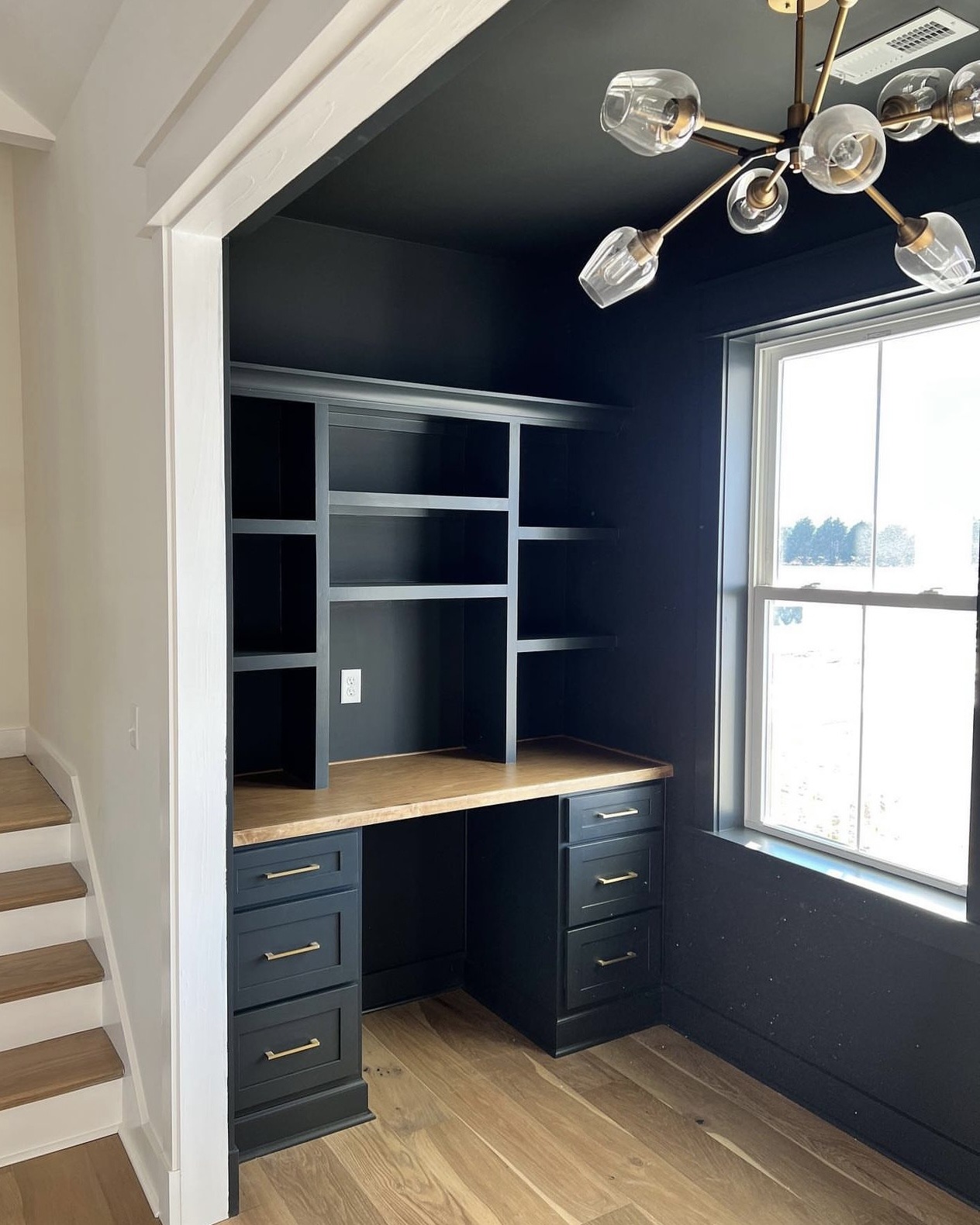
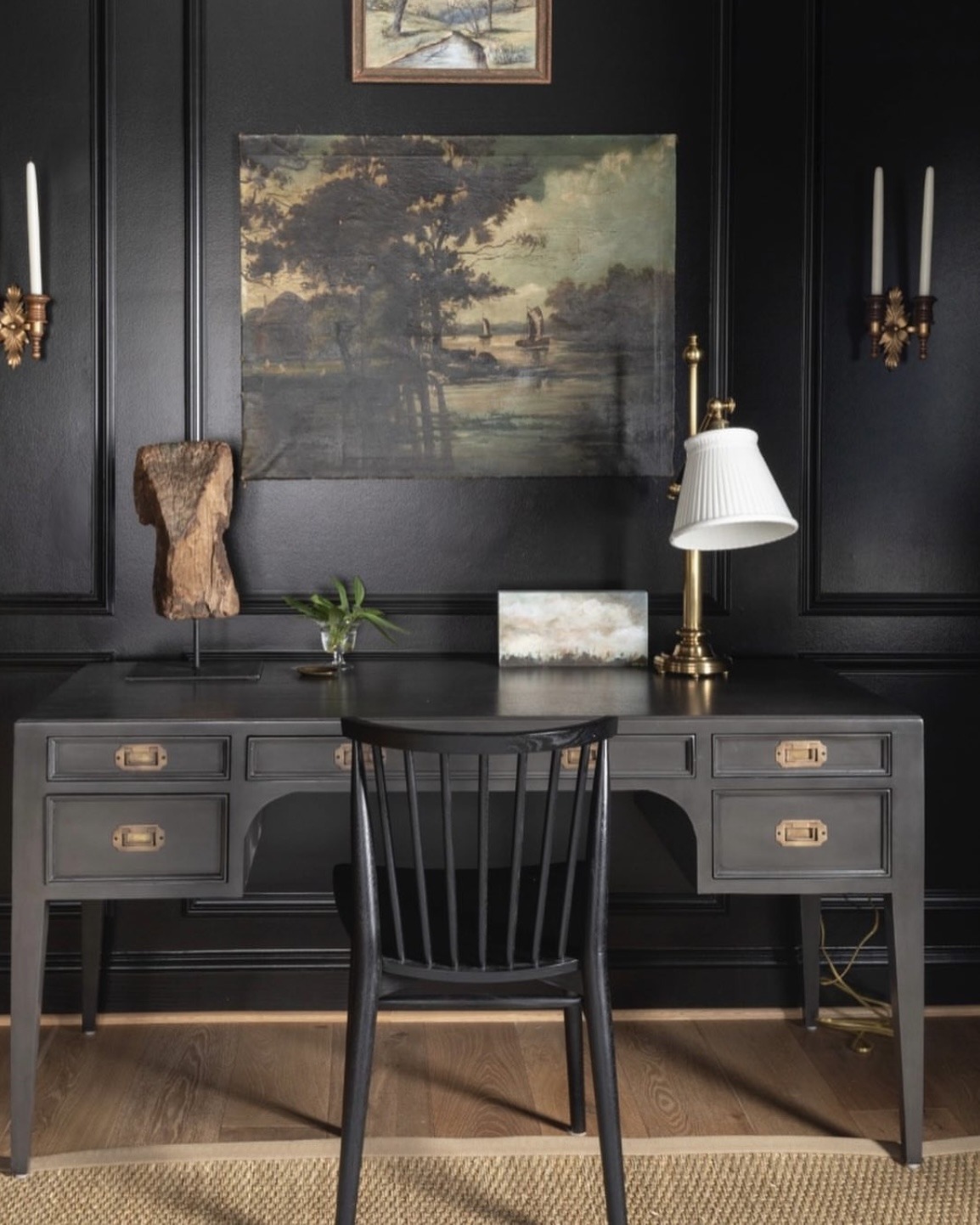
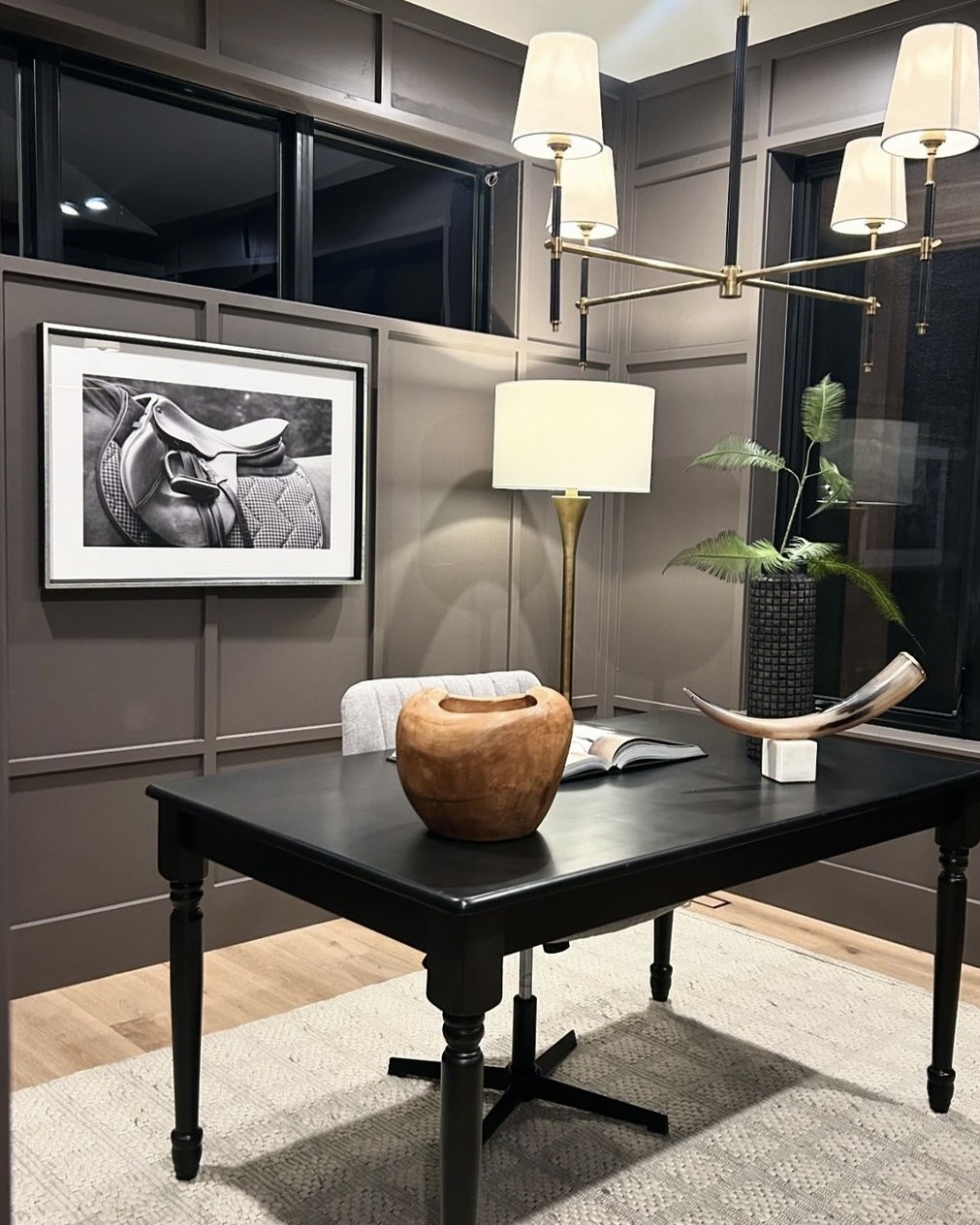
Tips for Creating a Moody Office on a Budget
Affordable Color and Lighting Options
DIY Painting Techniques
You don’t need to break the bank to create a moody office. DIY painting techniques, like sponging or ombre, can add depth and texture to your walls without the need for expensive wallpaper or professional painters.
Cost-Effective Lighting Solutions
Lighting doesn’t have to be costly either. Consider budget-friendly options like string lights, battery-operated candles, or thrifted lamps that you can customize with a fresh coat of paint or a new lampshade.
Budget-Friendly Decor Ideas
Thrifted and Upcycled Furniture
Thrift stores and flea markets are gold mines for budget-friendly furniture and decor. Look for pieces that you can easily upcycle with paint, new hardware, or upholstery. This not only saves money but also adds a personal touch to your office.
DIY Decor Projects That Add a Personal Touch
DIY projects can also be a fun and inexpensive way to add personality to your office. Whether it’s a handmade wall hanging, custom-painted picture frames, or a DIY bulletin board, these projects allow you to inject your own creativity into the space.
@rachlvalente ad | moody office makeover with this perfect Charcoal Louie Diamond Checkerboard jute from @rugs_usa ! 🌿🫒🏁 celebrating #earthweek with this eco-friendly jute (and all of Rugs USA’s other eco-friendly options!). you can use RACHV15 to save more 🫶🏼 this room was a surprise office makeover for my husband who works from home, with a faux limewash technique that took years off my life 😂 more details coming soon 🤎 #roommakeover #homeofficedecor #officemakeover #homedecordiyideas #organicmodern #limewashwall ♬ Moonlight - Villano
Maintaining the Moody Vibe
Regular Updates and Refreshes
Rotating Decor and Artwork for New Inspiration
To keep your office feeling fresh and inspiring, consider rotating your decor and artwork every few months. This could be as simple as swapping out throw pillows, changing up your desk accessories, or rotating the art on your walls.
Seasonal Updates to Keep the Space Feeling Fresh
Seasonal updates are another great way to maintain the moody vibe. Switch out heavier fabrics for lighter ones in the spring, or add cozy blankets and warm colors in the fall. These small changes can make a big difference in how your office feels throughout the year.
Keeping the Space Functional and Organized
The Importance of Decluttering
A clutter-free environment is essential for maintaining the moody vibe. Regularly declutter your workspace by removing items that you no longer use or that don’t contribute to the overall aesthetic. This will help keep your office looking and feeling its best.
Balancing Aesthetics with Productivity Needs
While aesthetics are important, your office should also be a functional space that supports your productivity. Strive to find a balance between creating a beautiful environment and ensuring that your workspace is organized and efficient.
Conclusion…
Creating a moody office is about more than just aesthetics—it’s about designing a space that enhances your productivity, stimulates your creativity, and makes you feel inspired every time you sit down to work. By carefully selecting colors, lighting, textures, and decor, you can transform even a small office into a moody and motivational environment that reflects your personality and supports your goals.
FAQs
What are the best colors for a moody office?
The best colors for a moody office are deep, rich tones like navy blue, forest green, charcoal gray, and burgundy. These colors create a sophisticated and calming atmosphere that’s conducive to productivity.
Can a small office space feel moody?
Absolutely! Even small offices can be transformed into moody spaces with the right color palette, lighting, and furniture arrangement. Using vertical space and choosing multi-functional furniture are key to maximizing the mood in a small area.
How do I choose the right lighting for a moody office?
The right lighting for a moody office should be a mix of natural and artificial light. Use ambient lighting to set the general mood, task lighting for specific work areas, and accent lighting to highlight decor and features.
What furniture works best in a moody office?
Dark wood and metal furniture work well in a moody office. Look for pieces that are both functional and stylish, such as a comfortable upholstered chair, a sleek metal desk, and plenty of storage options.
How can I maintain a moody office vibe over time?
To maintain a moody office vibe, regularly update your decor, rotate artwork for fresh inspiration, and keep the space organized. Seasonal changes to fabrics and decor can also help keep the space feeling fresh and inviting.
Desy Gregis
’m Desy, your new fashionista bestie. I’m an entrepreneur and business consultant living between Colombia and my home country, Italy. In this blog, we share news and trends about office fashion. I’m going to spill all the tea about how and why dressing for success is a fact.


You May Also Like
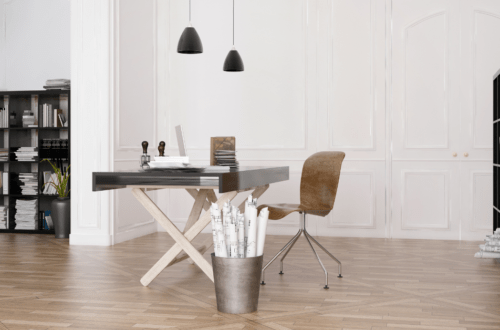
Neutral Office Decor: The Epitome of 2024/25 Elegance
August 20, 2024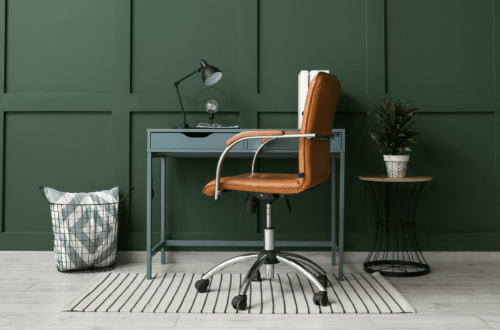
+20 Office Design Ideas in Stunning Green Shades
September 10, 2024